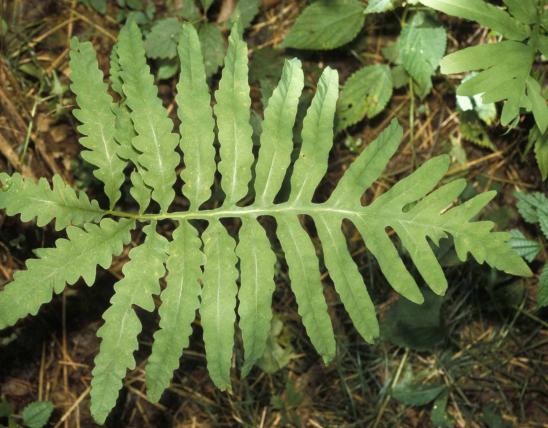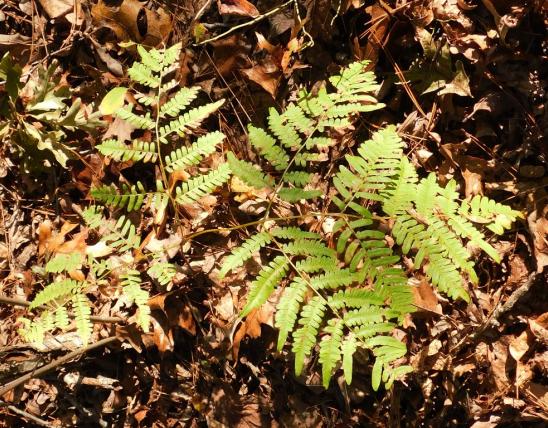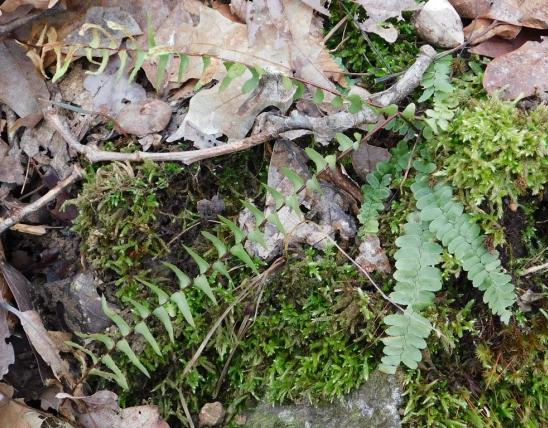
Broad beech fern is a perennial fern growing from branching, creeping, hairy rhizomes that have yellow or light brown, shiny scales. Leaf stalks are straw-colored, scaly or hairy at the base, hairless above. Stalks are usually longer than the blade, and the blades often tilt back from the tip of the upright stalk. Blades are triangular in general outline, deeply twice-pinnately lobed; the primary lobes are mostly connected by wings of leafy tissue along the main vein (rachis), with the lowest divisions rarely free. Lobes are hairy above and below, with small, stalked glands and scattered scales along the midrib of the undersurface. Lobes are themselves lobed or toothed. Spore clusters have round, with small, stalked glands and lack coverings (indusia). Spores are produced June–September.
Similar species: Northern beech fern (P. connectilis) occurs in western Illinois and might one day be found in eastern Missouri. It is smaller, and the lowest pair of leaflets are free (not winged).
Leaf length: 6–30 inches (includes stalk and leaf blade, from ground to leaf tip).
Scattered in the southern half of Missouri, and locally north to Marion County, mostly in the Ozark and Ozark Border regions.
Habitat and Conservation
Occurs in moist soils of wooded slopes along streams, in ravines, and on blufftops, mostly on acidic substrates, but also on limestone and dolomite. Occurs less commonly along the margins of fens and in bottomland forests.
Status
In the past, this fern has been placed in genus Polypodium, Dryopteris, and Thelypteris. As with many other plants, the relatively new tool of molecular (DNA) research has revealed the true genetic relationships between this species and other ferns.
Life Cycle
Ferns have a two-part life cycle. The plants we usually see are sporophytes, which produce spores. Spores germinate into gametophytes, which represent the second part of the life cycle. Gametophytes are small leaflike plants that produce gametes — eggs and sperm. The gametophytes in the marsh fern family are green, flat, heart-shaped or kidney-shaped, and usually with hairs or glands. When a gametophyte’s sperm fertilizes an egg, a new sporophyte plant develops, completing the cycle.
Broad beech fern also reproduces vegetatively, via its creeping and branching rhizomes. In this way, colonies may develop in an area.
Human Connections
This native Missouri fern can be naturalized in woodland and shade gardens, where soils are rich, acidic, medium-moist, and well-drained; they need part to full shade. It can spread somewhat aggressively, however. If you are considering planting this fern, please get your starts from a responsible nursery, or learn how to cultivate them yourself from spores. Please do not dig plants from the wild.
Ecosystem Connections
Apparently few insects or other animals eat this plant. It is associated with high-quality woodlands.
Regarding its common name: in our state, broad beech fern is more commonly found among oaks, maples, and hickories than it is to be found among beech trees. The natural range of this fern in Missouri is much larger than the natural range of beech trees in our state.


































